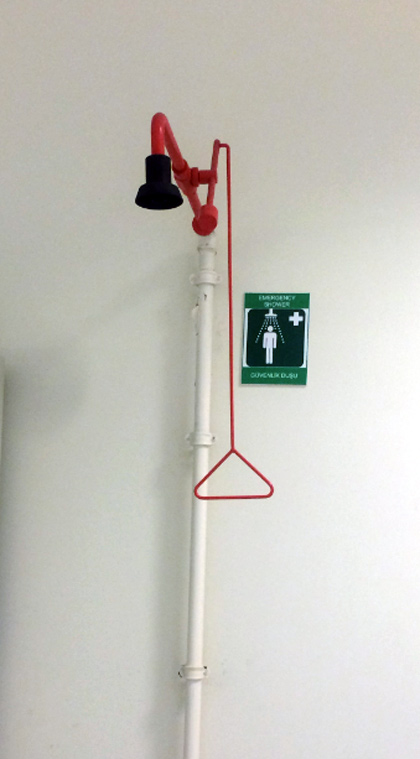Fire Extinguishers
Portable fire extinguishers are supplied in FENS building and are available to trained users. These types of extinguishers are based on the types of combustible and flammable materials in the lab (see Table 1.3). People who have been tutored in fire extinguisher use and the hazards involved may attempt to extinguish small and early stage of fires if there is an escape route. People who are not trained in the proper use of extinguishers should not use one during a fire.
Many fire extinguishers on campus are the multipurpose type, or ABC, which perform well on most fires with one major exception, combustible metal fires. Combustible metal (Class D) extinguishers are not typically provided for laboratories unless the need has been identified. Laboratories may request the addition of a CO2 extinguisher (Class BC). It is not as effective as a dry chemical extinguisher, but will require less clean up after use. Some pressurized water fire extinguishers (Class A,B,C and bioversal) are still found in hallways but they are only suitable for use on ordinary combustible materials (paper, wood, plastic, etc.). Fire extinguishers should be conspicuously located, wall mounted, and easily accessible.
Table 1.3: Classes of Fires and Proper Fire Extinguishers
Class of Fire
Description
Proper Extinguisher
A
Ordinary combustibles such as wood, cloth, and paper.
Dry Chemical (ABC) or water
B
Flammable liquids such as gasoline, oil, and oil-based paint.
Carbon Dioxide (BC) or Dry Chemical (ABC)
C
Energized electrical equipment including wiring, fuse boxes, circuit breakers, machinery, and appliances.
Carbon Dioxide (BC) or Dry Chemical (ABC)
D
Combustible metals such as aluminium, magnesium or sodium
Special Extinguisher (D)
Fire hoses may only be used by fire departmentpersonnel. Fire blankets are not recommended for laboratory use because they may trap heat in when a victim has burning clothes and cause more injury than would otherwise occur.
Eyewash Stations
If chemicals in use can cause eye damage, irritation or splash, an eyewash station(Figure B.4.) is required.
Laboratory users must be able to reach eyewash stations within ten seconds. The eyewash should be within 10 seconds walking distance of chemical use locations, although this distance may be less if doorways interfere with access.
Chemical splashes can cause temporary or permanent blindness, which can make it very difficult for someone to find the eyewash on their own in an emergency.

Figure B.4 Eyewash Station in G050
People who are involved in laboratories should know the location and how to operate eyewash stations in their area. It is recommended to the people to practice eyewash stations while keeping their eyes closed. The path to the eyewash station must be kept clear. Eyewashes must be tested in appointed period to monitor operation quality.
Emergency Showers
Laboratory users should know the location and how to use emergency showers (Figure 1.4) in their location.
Laboratory users must be able to reach showers within 10 seconds walking distance. The area underneath the shower and the path to the emergency shower must be kept always clear.

Figure 1.4: Emergency Showers in 2107